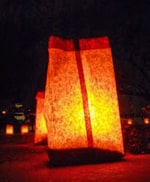 Farolito
Farolito
COMMUNITY News:
Farolitos or Luminarias? This question almost rivals the official state question, red or green?
On Christmas Eve, candlelights line the streets and houses in New Mexico. The words, farolitos and luminarias, are often interchangeably used in New Mexico to name the lights, which are constructed of a brown paper bag (think of a sack lunch), sand (to weigh the bag down and hold the candle in place), and a votive or tea candle. The lights are placed in lines and rows on the ground, along streets and sidewalks, around plazas, and on porches, parapets, porticos, and the flat rooftops in New Mexico.
 Luminaria
Luminaria
In a land which has had a large Catholic population, these lights traditionally have had a religious, symbolic significance for lighting the way of the Holy Family on Christmas Eve. The lights have been adopted in other places, and sometimes have been replaced by strings of plastic sacks and electric bulbs.
In Santa Fe and elsewhere in northern New Mexico, there is a long-held distinction between farolito, meaning one of these paper lights, and luminaria, meaning a small vigil fire or bonfire, but there are reports from some families and communities in this region, apparently less common by prevailing accounts, which call the small bonfires farolitos and the paper lights luminarias. In northern New Mexico, especially, the bonfire is traditionally constructed of fragrant piñon branches criss-crossed and stacked like a small box. The small bonfire may be used to mark a home hosting Las Posadas, a neighborhood re-enactment of Joseph and Mary’s search for a place to stay in Bethlehem, which takes place each night for nine nights before Christmas and which may include singing, praying, and food. Luminarias is the word used in Santa Fe for the bonfires found around the Canyon Road neighborhood on Christmas Eve. It is said, too, that these luminarias were originally used to light the way to midnight mass on Christmas Eve. Either luminarias or farolitos may also describe the candlelights used in the procession of Las Posadas.
Farolito appears to be a local word based on the Spanish word for lantern, “farol,” a word that may also be used loosely to describe a streetlamp. (El Farol, a long-established restaurant and cantina on Canyon Road in Santa Fe, has a lantern hanging in its porch.) Farolito is also close in form to farolillo, a Spanish word which is usually translated as a Chinese lantern. Some New Mexicans will swear that farolito means “little light;” others will claim it means “little fire;” but the better translation, the one espoused by northern New Mexicans most often, appears to be “little lantern.” Thus, the paper lights along the ground and on the rooftops are little lanterns or farolitos.
Luminaria doesn’t mean bonfire, per se. In Spanish, luminaria means a light or an illumination (la luz is the light), and there are other Spanish words used to describe bonfires. The word, luminaria, may be used in more specific contexts to describe festival lights, or an altar or sanctuary light or lamp, or a lamp which is kept burning in Catholic churches before the sacrament, or those candles lit before statues of saints in a Catholic church.
In Albuquerque, the candle-lit lights protected in paper bags, lining Old Town and the adjacent neighborhoods in the thousands, are still best known as luminarias. Luminarias appears to be the word used most often to describe the paper lights in other parts of the country, which have adopted them and to describe festival lights in other countries.
It is an ongoing, sometimes contentious, usually light-hearted, debate. While there is a belief that the words are synonymous, there also is a belief that the words divide the state geographically, with farolito prevailing in the northern part of New Mexico and luminaria prevailing in the southern part of New Mexico.
Source: tripadviser.com

